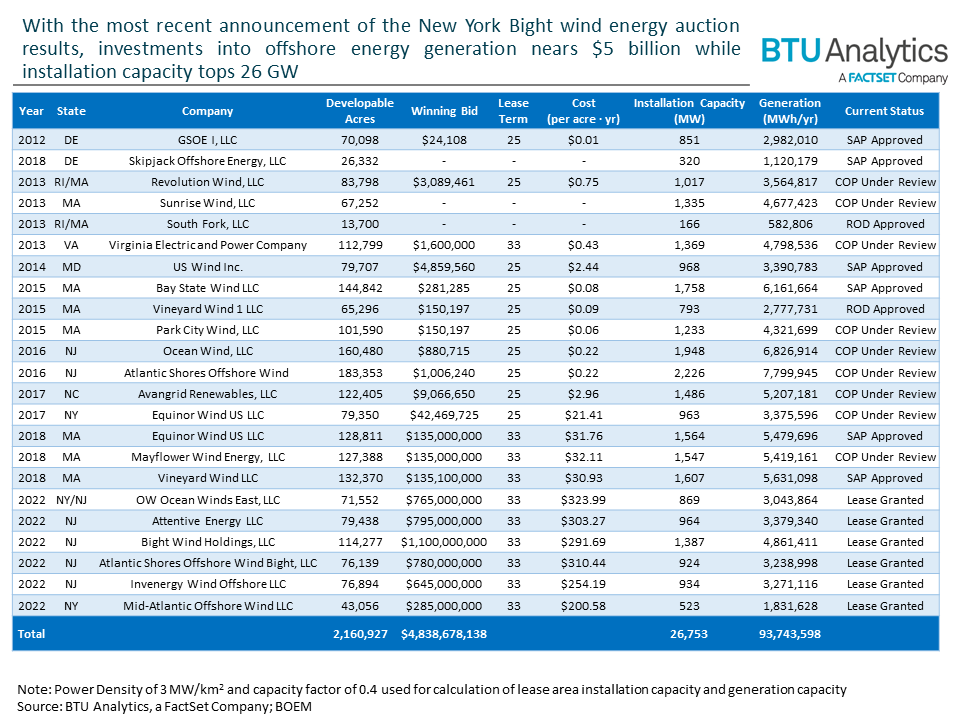More offshore wind projects are being proposed following the commitment of the Biden Administration to have 30 GW of offshore wind capacity by 2030. The strong wind resource off the coast of New England has led to 7.4 GW of planned offshore wind capacity in the Independent System Operator of New England (ISONE). Even though ISONE typically has the least load across all the ISOs, 7.4 GW represents the second highest amount of planned offshore wind capacity among all ISOs, only trailing PJM. This may lead to ISONE drastically decreasing their reliance on natural gas, which typically provides around 50% of their power. Today’s Energy Market Insight will focus on how the amount of natural gas generation may be impacted by offshore wind generation in New England.
Last month, the U.S. Bureau of Ocean Energy and Land Management (BOEM) held an auction on six lease areas in the New York Bight for offshore wind energy. These sales brought the total investments in offshore wind to $4.8 billion and the potential amount of installation capacity to 26 GW, as shown in the graphic below.

Following this auction, the BOEM has six more auctions planned by 2025, including for the Gulf of Maine in 2024, which would add additional offshore capacity for ISONE. This brings proposed offshore wind capacity in ISONE to about 7.4 GW by 2030.
However, before looking at the potential impact of this added generation, the potential retirement of the 2 GW Millstone Nuclear Power Station needs to be considered since it currently provides about 15% if ISONE’s generation. The state of Connecticut agreed to buy half of Millstone’s output through 2029 at a favorable rate due to Dominion Energy’s threats to close the plant. If no buyer is found at the end of 2029, Millstone will most likely retire. The following analysis will assume Millstone is retired.
So how much and what type of generation will be needed to meet ISONE demand? We’ll use net load, which is electricity demand less non-dispatchable resources (wind, solar, hydro), to determine how much thermal generation is needed. In this case, we also deducted nuclear generation in our net load calculation to simplify the historic versus future comparison. The following graphic stacks generating resources by cost (lowest cost at the bottom, highest at the top) and shows 2021 net load (solid red line) and net load adjusted for increased offshore wind generation and Millstone’s assumed retirement (dotted red line).

Even with Millstone’s retirement, offshore wind will still cut into natural gas generation. From June to September, when offshore wind has its lowest capacity factor in New England, gas would still provide at least 6.2 GWh on average, which is down from the season’s 2021 average of 9.1 GWh. However, offshore wind generation could decrease the natural gas generation needed in April from an average of 5.6GWh to just 1 GWh.
Monthly aggregation can obfuscate the hour-to-hour dynamics of power markets, so let’s look at how this stacks up intraday in April. We can see that when overall load is at its lowest during midday, net load nears zero.

This implies that ISONE will have times of near 100% carbon free generation and may be able to export offshore wind production to New York under the right circumstances. Furthermore, if Millstone remains in service, ISONE will be even closer to a 100% carbon free grid during months of high offshore wind generation. However, this does not consider any load growth over 2021 levels. With ISONE calling for peak load growth, offshore wind’s effects on dispatchable generation would be lessened.
While offshore wind generation is less volatile month-to-month and hour-to-hour, it is still an intermittent resource. Without structural change to ISONE (and other ISOs), many gas plants will be forced into retirement. However, when the wind stops blowing, the dispatchable fleet will need to be called into service. Will there be enough thermal capacity to keep the lights on? Or will batteries be relied on during times of faltering wind production? We’ll explore these topics further in coming Energy Market Insights.








